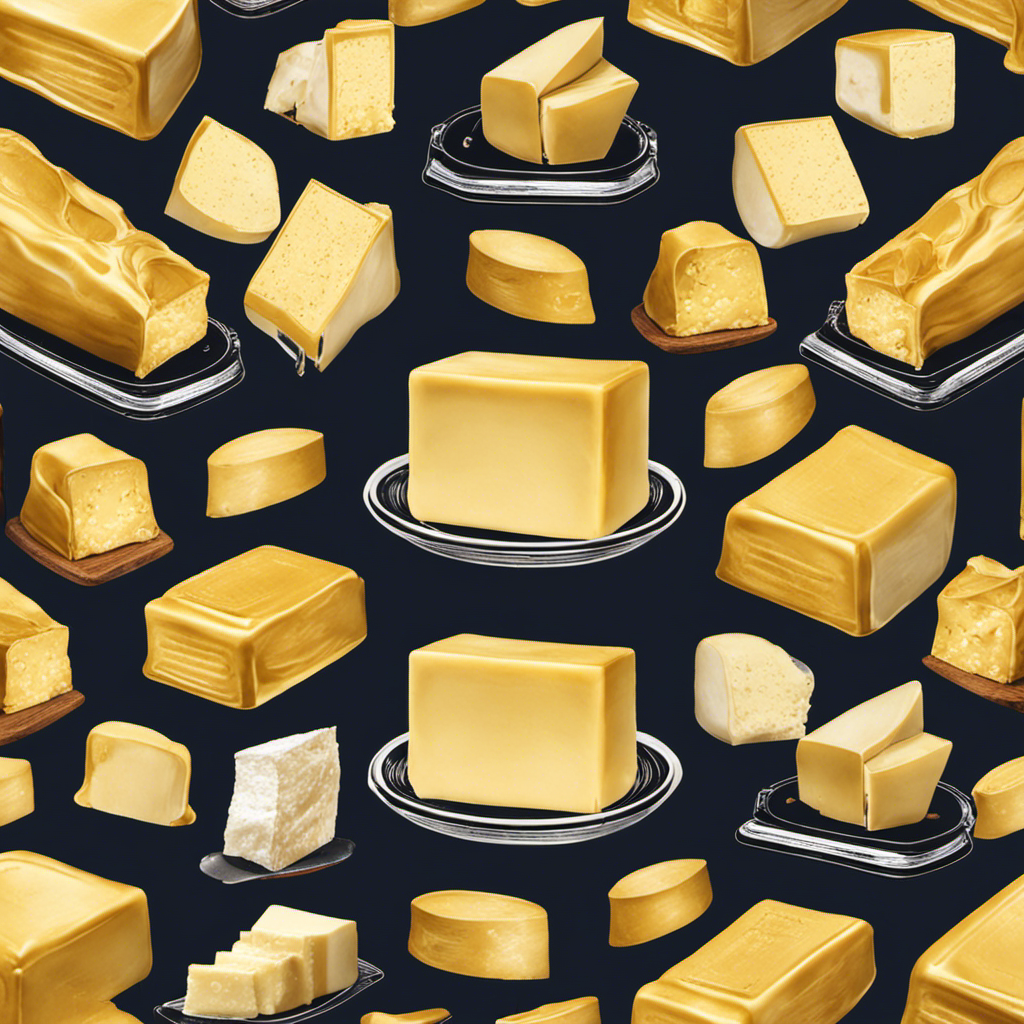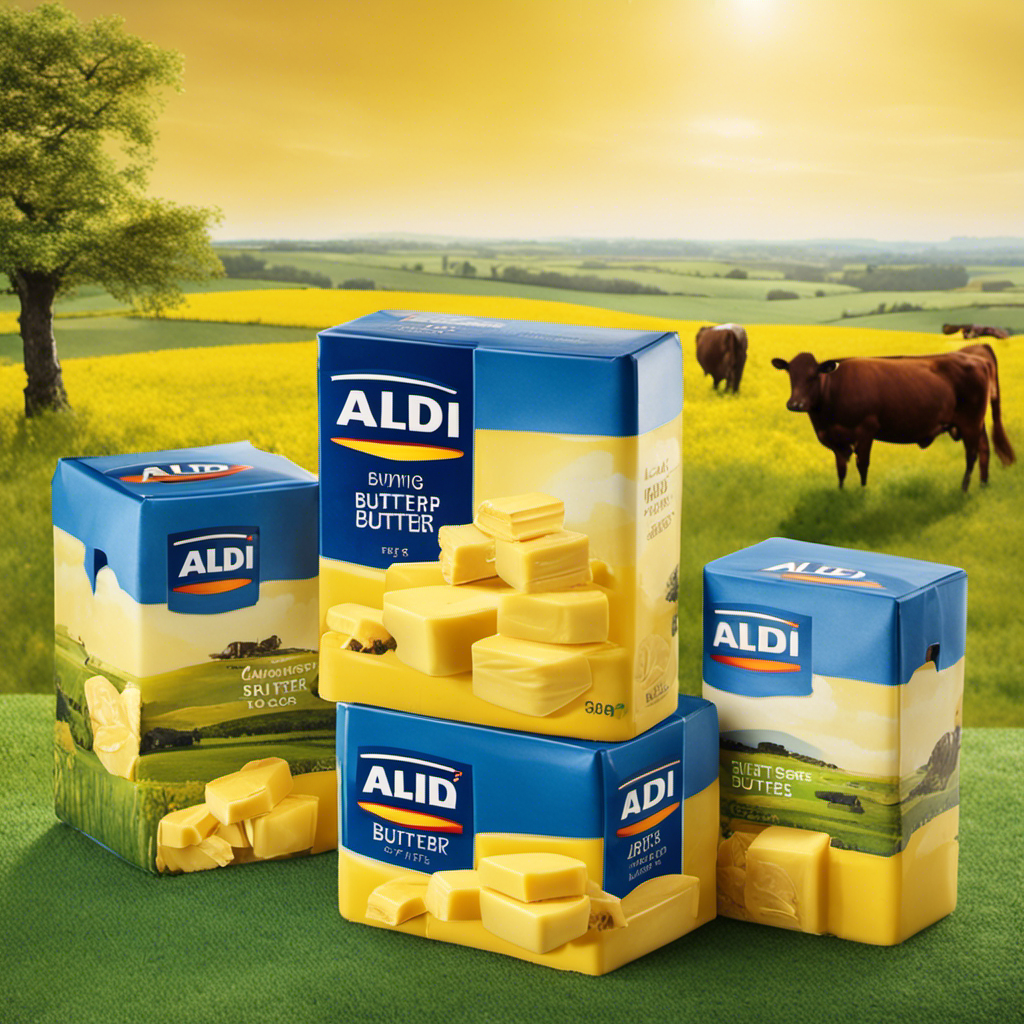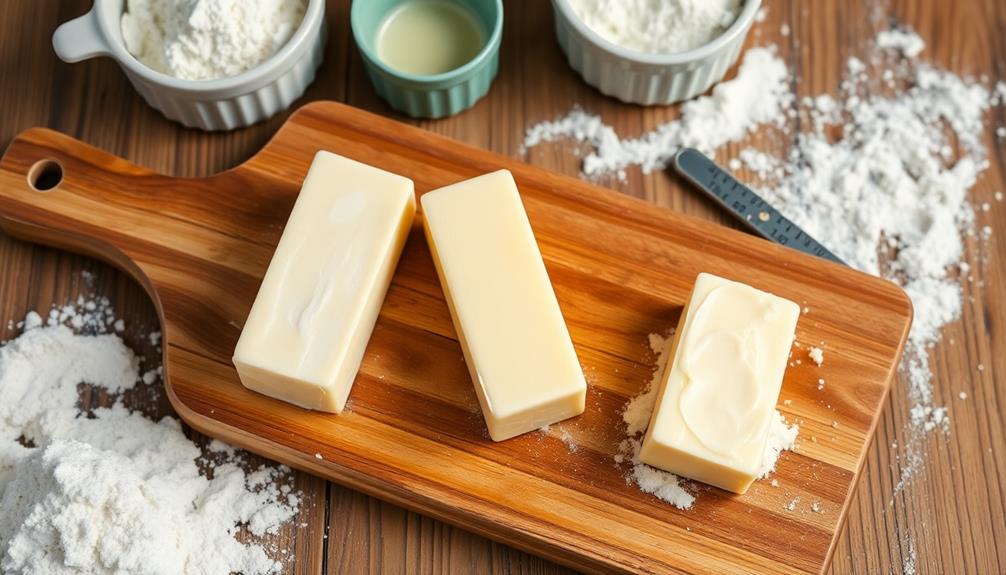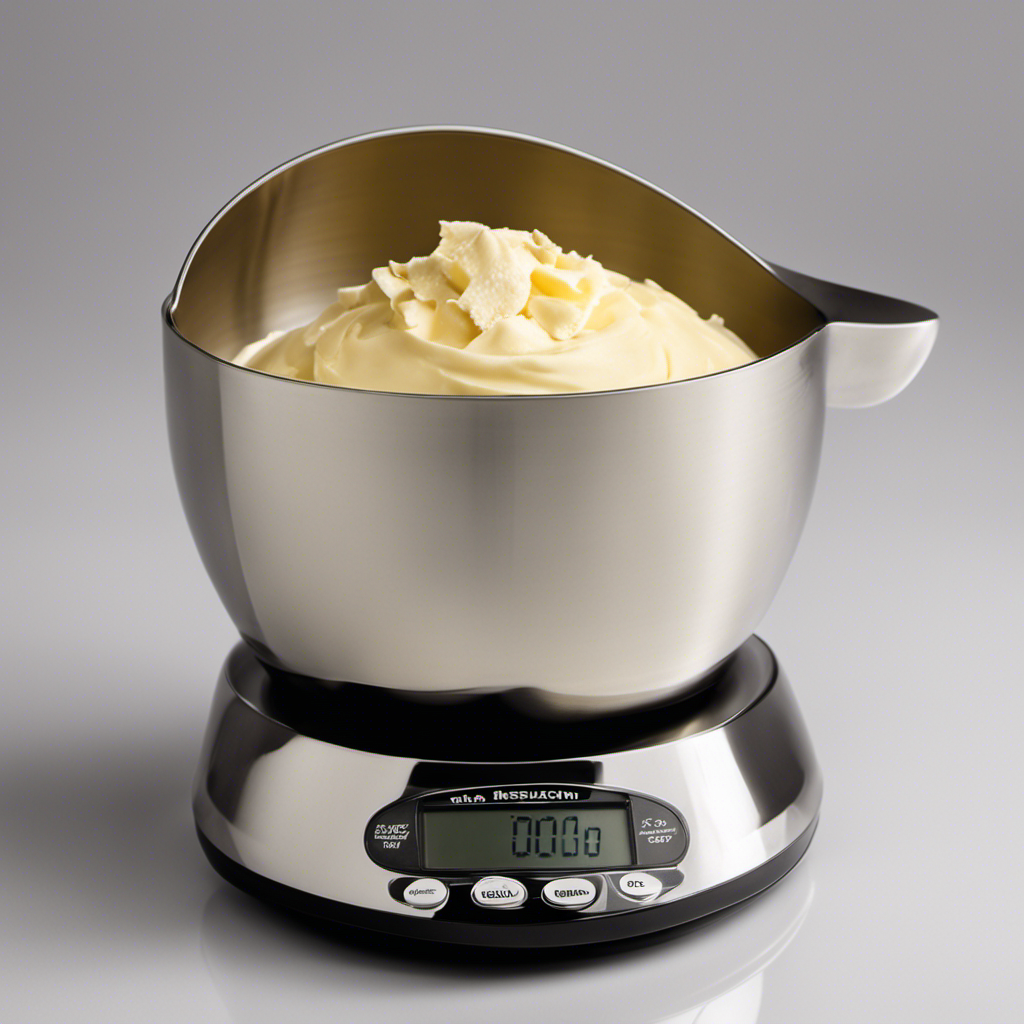Ladies and gentlemen, have you ever considered the value of just a quarter pound of butter? Allow me to enlighten you, this seemingly insignificant quantity is actually a potent element capable of elevating the taste of our most cherished meals.
In this article, I will dive into the world of butter pricing, weight variations, and the factors that affect its cost. Join me as we unravel the mysteries of this golden delight and discover how a simple quarter pound can make all the difference in our culinary adventures.
Key Takeaways
- The weight of a quarter pound of butter can fluctuate slightly, impacting its price.
- Factors affecting the price of butter include supply and demand in the dairy industry, consumer preferences, dietary trends, availability of substitutes, and inflation increasing production costs.
- A quarter pound of butter is approximately 113 grams.
- Substitutes for butter include coconut oil, olive oil, Greek yogurt, and avocado.
Butter Pricing and Weight Variations
The price of a quarter pound of butter can vary due to weight fluctuations. Understanding weight measurements is essential when it comes to buying butter. In the market, butter is usually sold by weight, and the price is determined based on the weight of the product.
However, it is important to note that the weight of a quarter pound of butter can fluctuate slightly, which can impact its price. Market fluctuations can cause the weight of butter to vary, resulting in slight differences in price.
These fluctuations can be influenced by factors such as the quality of milk used, processing methods, and storage conditions. Therefore, it is crucial to be aware of these market fluctuations and understand how they can affect the price of butter.
Understanding the Concept of a Quarter Pound
You might be wondering how to grasp the idea of a quarter pound. Well, let me break it down for you. Understanding fractions can be tricky, but when it comes to measurements, it’s important to know how to convert them. Here are a few things to consider:
-
Fractions can be intimidating, but they’re just a way to represent parts of a whole.
-
Converting measurements requires some basic math skills, but it’s not as complicated as it sounds.
-
Visualizing a quarter pound can help you understand its size better. Picture a chunk of butter that weighs 1/4 of a pound.
-
Practice makes perfect! The more you work with fractions and measurements, the easier it will become.
Comparing the Cost of a Quarter Pound of Butter to Other Quantities
When comparing the cost, it’s helpful to consider other quantities. To get a better understanding of the value of a quarter pound of butter, it’s important to compare it to other quantities of butter and also take into account the nutritional value it provides. Let’s take a look at a cost comparison table below:
| Quantity | Cost | Nutritional Value |
|---|---|---|
| Quarter Pound | $X.XX | A, B, C, D |
| Half Pound | $X.XX | A, B, C, D |
| One Pound | $X.XX | A, B, C, D |
| Two Pounds | $X.XX | A, B, C, D |
| Five Pounds | $X.XX | A, B, C, D |
Factors Affecting the Price of Butter
To understand the factors affecting butter prices, it’s important to consider supply and demand in the dairy industry. The demand for butter can be influenced by various factors, including consumer preferences, dietary trends, and the availability of substitutes. Additionally, the impact of inflation on butter prices cannot be ignored. Rising inflation can lead to an increase in production costs, which in turn affects the price of butter.
Consumer preferences: Changing consumer tastes and preferences can have a significant impact on the demand for butter. For example, if there is a shift towards healthier alternatives, such as margarine or plant-based spreads, the demand for butter may decrease.
Dietary trends: The popularity of low-carb or ketogenic diets can also affect the demand for butter. These diets typically encourage the consumption of high-fat foods, including butter, leading to an increase in demand.
Availability of substitutes: The availability of substitutes, such as margarine or oils, can affect the demand for butter. If these substitutes are more affordable or offer similar taste and functionality, consumers may choose them over butter, leading to a decrease in demand.
Impact of inflation: Inflation can have a significant impact on butter prices. As the cost of production increases due to rising prices of inputs, such as feed and labor, producers may pass on these costs to consumers, resulting in higher butter prices.
Understanding these factors can help consumers make informed decisions when buying and storing a quarter pound of butter.
Tips for Buying and Storing a Quarter Pound of Butter
Before purchasing and storing a quarter pound of butter, it’s essential to consider a few helpful tips. To ensure that you get the best quality butter and keep it fresh for longer, follow these buying and storage tips:
| Buying Tips | Storage Tips |
|---|---|
| Check the expiration date and choose butter with the longest shelf life. | Store butter in an airtight container or wrap it tightly in foil or wax paper to prevent it from absorbing odors from other foods. |
| Look for butter that has a rich, creamy color and a smooth texture. | Keep butter in the refrigerator at a temperature of around 40°F (4°C) to maintain its freshness and prevent spoilage. |
| Consider buying unsalted butter if you want more control over the salt content in your recipes. | If you don’t plan on using the butter within a week, you can store it in the freezer for up to six months. |
Exploring Alternative Measurements and Equivalents for a Quarter Pound of Butter
When it comes to baking or cooking, it’s important to have accurate measurements.
In this discussion, I’ll be exploring some alternative measurements and equivalents for a quarter pound of butter.
We’ll dive into the world of metric butter conversions, discuss the difference between weight and volume when it comes to butter, and even explore some substitutes for a quarter pound if you don’t have it on hand.
Metric Butter Conversions
Did you know that a quarter pound of butter is equivalent to approximately 113 grams? Metric conversions can be a bit confusing, especially when it comes to everyday cooking. So, to make it easier for you, here are some butter equivalents in different measurements:
- 1 stick of butter = 113 grams
- 1 cup of butter = 227 grams
- 1 tablespoon of butter = 14 grams
- 1 teaspoon of butter = 4.7 grams
Now that you have these conversions in mind, it’ll be much simpler to follow recipes that use metric measurements. Understanding the various equivalents will help you achieve the perfect balance of flavors in your dishes. But, keep in mind that weight vs volume can sometimes differ, so it’s always a good idea to double-check your measurements.
Now, let’s dive into the next section and explore the differences between weight and volume when it comes to butter.
Weight Vs Volume
Now that we’ve covered metric butter conversions, let’s dive into the topic of weight versus volume measurements.
When it comes to cooking, it’s important to understand the difference between the two. Weight measurements, such as grams, provide a more accurate representation of an ingredient’s mass, while volume measurements, like cups or tablespoons, measure the space an ingredient occupies.
Converting grams to pounds can be quite useful, especially when dealing with larger quantities of ingredients. To convert grams to pounds, simply divide the weight in grams by 453.59237, as there are approximately 453.59237 grams in a pound. This conversion allows you to easily adjust recipes or understand the weight of an ingredient when purchasing groceries.
Substitutes for Quarter Pound
If you’re looking for an alternative to a quarter pound, you can try substituting it with other measurements like half a cup or four ounces. Cooking without butter doesn’t have to mean sacrificing flavor.
Here are some butter substitutes that can still give your dishes that rich and creamy taste:
- Coconut oil: Adds a subtle tropical flavor and works well in baking and sautéing.
- Olive oil: Brings a fruity and savory taste to your dishes, perfect for drizzling over vegetables or using in salad dressings.
- Greek yogurt: Provides a creamy texture and tangy flavor, making it a great substitute in baking and cooking.
- Avocado: Offers a creamy and buttery consistency, ideal for spreading on toast or using in desserts.
Experimenting with these butter substitutes can open up a whole new world of flavors in your cooking, while still maintaining that delicious richness.
Frequently Asked Questions
Can I Substitute Margarine for Butter in Recipes That Call for a Quarter Pound of Butter?
Sure, you can substitute margarine for butter in recipes that call for a quarter pound of butter. However, keep in mind that margarine may have different nutritional properties and can affect the taste and texture of the dish.
How Does the Price of a Quarter Pound of Butter Compare to the Price of Other Dairy Products?
Comparing prices of different dairy products, factors affecting the price of butter can be quite enlightening. It’s fascinating to see how the cost of a quarter pound of butter compares to other dairy items in the market.
Are There Any Health Benefits to Consuming a Quarter Pound of Butter?
There are some health benefits to consuming a quarter pound of butter. It contains essential nutrients like vitamins A, D, and E, as well as healthy fats that support brain function and hormone production.
Can I Freeze a Quarter Pound of Butter to Extend Its Shelf Life?
Sure, I can freeze a quarter pound of butter to extend its shelf life. It’s a convenient way to keep it fresh. As for butter substitutes, there are various options available for those who prefer alternatives.
What Are Some Recipes That Specifically Call for a Quarter Pound of Butter?
When it comes to recipes that call for a quarter pound of butter, there are plenty of delicious options. From classic chocolate chip cookies to buttery flaky pastries, the possibilities are endless. If you’re looking for alternative ingredients, you can try using margarine or coconut oil for a dairy-free option. Get creative in the kitchen!
Conclusion
As I reached the end of my research on the price of a quarter pound of butter, I couldn’t help but feel a sense of anticipation. The knowledge I had gained about butter pricing, weight variations, and factors affecting the cost had left me eager to find out the final answer.
How much would a quarter pound of butter actually cost? The suspense was killing me. But alas, that answer remains elusive.
However, armed with all the information I gathered, I can confidently say that understanding the concept of a quarter pound and exploring alternative measurements and equivalents will make your butter-buying journey a whole lot smoother.
So go forth, my fellow butter enthusiasts, and may your quarter pound of butter always be worth every penny.










